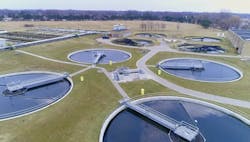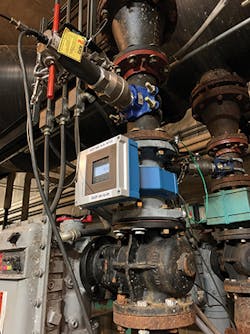Just as potentially life-sustaining planets need to occupy a "Goldilocks zone" that isn't too hot or too cold for liquid water, most process applications must also run in acceptable ranges. The trick for earthly users is securing the data required for timely adjustments and optimization, which often means collecting it from difficult or historically impossible-to-reach settings that might as well be in outer space.
For instance, the Water Recovery Facility in Warren, Mich., operates a waste-activated sludge application that sends worn-out microorganisms from its wastewater aeration facilities to be incinerated. This process combines old sludge activated by diverted primary/updated sludge, which is combined with one gallon of polymer diluted in 1,000 gallons of water. This lets a belt press dewater the sludge down to cake that's 18-20% solids, which is best-suited for burning and scrubbing in compliance with Michigan's clean-air regulations and even approaching California-level clean-air rules.
This application can process 340 gallons per minute of activated sludge, using 3 gallons per minute of the polymer solution, and produce 5-5.5 tons of cake per hour. However, its flows must be accurately monitored and precisely maintained to avoid ineffective use of its chemicals and overuse of its power.
"Once the secondary clarifiers have settled down, our waste-activated sludge process intercepts some of the return flow, and sends it to sludge-handling storage to prepare it for incineration," says Bryan Clor, head of the wastewater treatment division for the City of Warren, just north of Detroit. "In past years, there was less automation and more guessing. Overdosing would waste costly chemicals, but under-dosing was also a problem because it could produce cake that incinerated inefficiently, and cause the furnace to burn for too long and waste fuel. We could incinerate at 28-30% solids, but we find it's better at 18-20% solids."
Historical hurdles
In general, Warren's gravity-fed Water Recovery Facility was built in 1957, and is designed to process about 60 million gallons per day (gpd) of wastewater, though it can handle a peak of 100 million gpd, and usually processes about 22 million gpd (Figure 1). The facility serves about 135,000 residents over an area of about 36 square miles.
However, the plant's two, 6-inch, waste-activated sludge lines used Endress+Hauser flowmeters that were now 35 years old. They were still operating as intended, but weren't easy to validate. Operators could compare their readings with other meters installed downstream and make decisions based on those comparisons, but updated technology would provide more accurate information and allow easier decisions. In addition, the old flowmeters needed constant recalibration, and securing their non-repeatable data was using up added time and money.
"The previous meters were good, and even without straight runs upstream and downstream, they could still measure flows to ±3%, though it took a lot of added math and recalibrations," explains Clor. "We just needed more accuracy, and we needed to do it in the same footprint."
Space constraints
Because its users strive to improve process control and operations, the Water Recovery Facility's activated sludge process had to implement electromagnetic flowmeters that could also serve in the same space-limited, zero-straight-pipe-run setting as its former meters (Figure 2). Just as in many legacy applications, the new flowmeters would have to fit in the former space to avoid major and often prohibitive reengineering and reconstruction costs. In Warren's case, changing existing pipes and adding new ones would have cost about $20,000 for each of the two 6-inch lines, labor would have cost about $5,000 per line, and motors and other new components would have cost another $5,000 per line.
"If we'd had to use a new flowmeter that wouldn't fit the existing space, reconfiguring piping and other costs would have pushed the costs of this installation three to four times higher," adds Clor. "It would have cost about $30,000 more per flowmeter, or about $60,000 for the two we needed."
Figure 2: The Water Recovery Facility replaced two 35-year-old flowmeters from Endress+Hauser with two Promag W unrestricted mounting 0 x DN electromagnetic flowmeters in its waste-activated sludge lines because they don't need straight pipe runs. The new meters fit in the existing space, and didn't need reconfigured piping, which saved about $60,000 for the pair, and provides ±0.5% accuracy, and saves about $100,000 per year in operating costs. Source: City of Warren, Mich., and Endress+Hauser
Fitting in the flow
Fortunately, Clor and his colleagues collaborated with longtime distributor Forberg Scientific in Troy, Mich., and they concluded the most effective way to improve the waste-activated sludge line's flow-measurement accuracy without altering its footprint was to implement Endress+Hauser's Promag W unrestricted mounting 0 x DN electromagnetic flowmeter because it's not subject to typical pressure loss concerns or straight-pipe-run requirements. It could be mounted directly into lines and processes with the same lay length as the existing devices it replaced, which eliminated the need for added pipe or installation costs.
Promag W also measures flow independent of the line's flow profile and its mounting location, which made it ideal for Warren's sludge application. Its 0.5% accuracy and repeatability mean the utility's staffers no longer have to constantly check, compare and confirm data from the former flowmeters with data from downstream meters, and instead have the reassurance of being able to trust data they're getting from their new flowmeters. More accurate flow data also lets the Water Recovery Facility balance its sludge mixture more efficiently and run its furnace more cost-effectively.
"Promag W has six measuring electrodes arranged in three pairs on the sides of the flow tube and a enhanced coil system behind them that enable its electromagnetic measurements," says Clor. "We installed two in March 2020, including one going into the 1/1,000 polymer solution storage tank, which has to run at up to 75 gallons per minute. Promag W and its multiple electrodes gave us a much better accuracy rate of ±0.5%. Plus, we don't have to do extra math to compare with downstream meters, and we don't have to do added calibrations. We're basically twice as efficient now, and save the city about $100,000 per year."
Future, built-on benefits
Beyond improving its flow measurement accuracy and sludge incineration process, Clor adds that Promag W will likely enable the Water Recovery Facility to achieve several more gains going forward. "We are looking at refining our application further, so we can develop a way to capture some phosphorus from our belt press, and convert it into brushite, which is an organic phosphate that can be sold," adds Clor. "In addition, the incineration process only produces a little ash as a byproduct, so we only need to have it hauled about three times per year. However, we're also seeing if it might be used as an ingredient in a 3D printing process for cement. This is another reason why it's good to have partners like Endress+Hauser and Forberg Scientific because we know they'll help us with any of the crazy ideas we come up with."
About the Author

Leaders relevant to this article:



